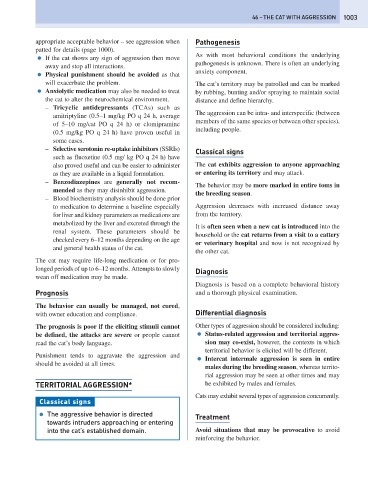Page 1011 - Problem-Based Feline Medicine
P. 1011
46 – THE CAT WITH AGGRESSION 1003
appropriate acceptable behavior – see aggression when Pathogenesis
patted for details (page 1000).
As with most behavioral conditions the underlying
● If the cat shows any sign of aggression then move
pathogenesis is unknown. There is often an underlying
away and stop all interactions.
anxiety component.
● Physical punishment should be avoided as that
will exacerbate the problem. The cat’s territory may be patrolled and can be marked
● Anxiolytic medication may also be needed to treat by rubbing, bunting and/or spraying to maintain social
the cat to alter the neurochemical environment. distance and define hierarchy.
– Tricyclic antidepressants (TCAs) such as
The aggression can be intra- and interspecific (between
amitriptyline (0.5–1 mg/kg PO q 24 h, average
members of the same species or between other species),
of 5–10 mg/cat PO q 24 h) or clomipramine
including people.
(0.5 mg/kg PO q 24 h) have proven useful in
some cases.
– Selective serotonin re-uptake inhibitors (SSRIs)
Classical signs
such as fluoxetine (0.5 mg/ kg PO q 24 h) have
also proved useful and can be easier to administer The cat exhibits aggression to anyone approaching
as they are available in a liquid formulation. or entering its territory and may attack.
– Benzodiazepines are generally not recom-
The behavior may be more marked in entire toms in
mended as they may disinhibit aggression.
the breeding season.
– Blood biochemistry analysis should be done prior
to medication to determine a baseline especially Aggression decreases with increased distance away
for liver and kidney parameters as medications are from the territory.
metabolized by the liver and excreted through the
It is often seen when a new cat is introduced into the
renal system. These parameters should be
household or the cat returns from a visit to a cattery
checked every 6–12 months depending on the age
or veterinary hospital and now is not recognized by
and general health status of the cat.
the other cat.
The cat may require life-long medication or for pro-
longed periods of up to 6–12 months. Attempts to slowly
Diagnosis
wean off medication may be made.
Diagnosis is based on a complete behavioral history
Prognosis and a thorough physical examination.
The behavior can usually be managed, not cured,
with owner education and compliance. Differential diagnosis
The prognosis is poor if the eliciting stimuli cannot Other types of aggression should be considered including:
be defined, the attacks are severe or people cannot ● Status-related aggression and territorial aggres-
read the cat’s body language. sion may co-exist, however, the contexts in which
territorial behavior is elicited will be different.
Punishment tends to aggravate the aggression and
● Intercat intermale aggression is seen in entire
should be avoided at all times.
males during the breeding season, whereas territo-
rial aggression may be seen at other times and may
TERRITORIAL AGGRESSION* be exhibited by males and females.
Cats may exhibit several types of aggression concurrently.
Classical signs
● The aggressive behavior is directed Treatment
towards intruders approaching or entering
into the cat’s established domain. Avoid situations that may be provocative to avoid
reinforcing the behavior.

